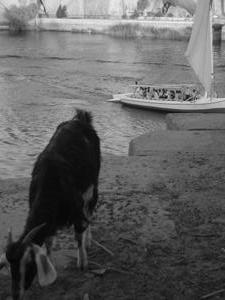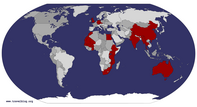Advertisement
Published: April 23rd 2007

 Nubian goat
Nubian goat
A goat looking for food amongst the Graeco-Roman ruins of Elephantine Island, in the middle of the Nile at Aswan
Tom Griffith
An Aswani Ahwa One of the best ways to experience Egypt is to sit back in a coffee-shop, tea in hand, and talk crap with the locals who will invariably be attracted to your table. I try to do this at least once a day - mint tea and a waterpipe at the local
ahwa are about as close as you can get to downing a schooner of beer at the pub. The ahwas are where Egyptian men gather, day and night, to talk, argue, smoke, play games, watch telly, and relax. Dropping into one, you usually get to meet some interesting characters, play a game or two of
tawla (backgammon), and practise your Arabic.
After my first day in Aswan, I was feeling a little Egypted-out, so I sought refuge in a friendly-looking place in the tourist market. I had to bargain the price of my sheesha and shaay - usually 20 cents each in Cairo, but in the tourist-saturated south you pay double, triple, five times that. A couple of nice chaps called Bastoui and Hussein joined me, and we spent a good two hours discussing everything from politics (President Hosni Mubarak is a 'very bad man' who steals from

 Abu Simbel
Abu Simbel
The incredible Great Temple of Abu Simbel, in the far south of Egypt. The temple was dismantled piece by piece and reassembled within a man-made hillside, to escape the encroaching waters of Lake Nasser in the mid-1960sthe people, and John Howard is okay because at least the Australian people can get rid of him) to the effects of herbs and spices on your libido (ginger makes you frisky, but mint makes you flaccid). Every now and again, a group of foreigners would wander past, and the guy called Bastoui would leap from his chair, yell, 'Hola!', or 'Bonjour!', or 'Hello Aussie!', and try to sell the poor bastards a scarf. When he returned, I asked them how they could tell that the people walking past were Spanish, English, French, Australian. They let me in on their little secret, and I will do the same for you:
English - wear lots of gold jewellery, especially square rings.
Japanese - are usually young, and wear scruffy clothes; but are very hard to distinguish from Chinese.
French - most of them wear glasses, and the women's hair is a dead giveaway.
Germans - the men wear denim shorts a lot.
Russians - dressed like they are still teenagers, in a Moscow winter.
Dutch - tall and fat, because, apparently, 'milk is very cheap there'.
Americans - big and muscley; 'even the girls are very tall'.
Turkish - very big

 Khnum's Temple
Khnum's Temple
Looking back over Elephantine Island from the temple of the ram-headed god, Khnum. The buildings along the island belong to a traditional Nubian village, and Aswan sits on the other side of the rivermoustaches.
Australians - all under 30, scruffy, and always carrying a Lonely Planet under their arm...which is pretty spot on, I have to admit.
So, after revealing this, we spent a while trying to guess who was from where. It was quite disconcerting to see just how many Australians fitted their stereotype...
Aswan is Egypt's southernmost city, about 300 kilometres further down the Nile from Luxor. It is incredibly scenic, sitting on a broad, island-infested stretch of the mighty river, with the desert biting at its heels just a kilometre or two from the banks. The place feels quite different to the rest of Egypt - partly because of the climate, which is hot and humid, and not conducive to moving too fast; and partly because of the large minority of Nubians, a darker-skinned southern ethnic group, with a culture that differs in some respects from that of the Arab north.
Like Luxor, Aswan has a large number of ancient ruins that pull the tourist crowds in, and it also has the associated hassle and rip-offs. I had heard that Aswan was a lot more relaxed than Luxor in this respect, but I have still been treated

 Ramesses II
Ramesses II
One of the 20-metre high colossal statues of Ramesses, guarding the entrance of his famous temple at Abu Simbellike a walking wallet since I arrived here. You do get used to bargaining in Egypt, but here I have even had to negotiate the price of a cup of tea and use of the internet. I have been putting on my best Arabic and telling the salespeople I am 'shuwayya Masri' (a little Egyptian), and this either gets a broad smile and a small discount, or a rude snigger and none.
Within the town itself, the main attraction is the Nile River, and the large island that sits in the middle of it, Elephantine. Nobody is really sure how it got its name, but the grey boulders scattered around its edges do resemble bathing elephants. If you've got really bad eyesight and you're a bit mad. On the southern tip of the islet are some okay ruins, consisting of a temple, a Roman-era quay, and a water-depth measuring Nilometer. The ruins were closed when I arrived there just before sunset, but as ever a bit of
baksheesh for the temple cop came in handy. Baksheesh is basically a tip for services rendered, or for opening closed doors. In Egypt it gets ridiculous - in every temple, guys point

 African prisoners
African prisoners
A carving at Abu Simbel, showing some of the defeated Africans taken prisoner by Ramesses in one of his military victoriesat hieroglyphs on the wall that are plainly visible, and then stick their hand out for some money, or offer to take a photo of you with your camera, and then demand a fee - but sometimes it can be useful. In this case, I got the temple ruins to myself (well, there were three goats there too) as the sun set over the Nile.
The real reason most people come to Aswan, however, is to see the magnificent ruins at Abu Simbel. This is the famous temple of Ramesses II, built into a hillside, with the four huge statues of the great pharaoh standing sentinel at the entrance. The ruins actually lie almost 300 kilometres south of Aswan, just near the Sudanese border, but Aswan is the nearest town of any size, so most people visit from here. Since the attack at Hatshepsut's Temple 10 years ago, official paranoia dictates that all foreigners must visit Abu Simbel in the notorious 'tourist convoy'. What this means is that, every morning at 4 o'clock, 20 to 50 buses packed full of westerners, and escorted by police vehicles, speed through the desert in one long juggernaut, all arrive at Abu Simbel

 Four massive guys
Four massive guys
The facade of the temple at Abu Simbel, with the four colossal figures of Ramesses II. The rubble at the bottom is the remains of the second statue alongat the same time, check it out, and then speed back. This circus makes no sense for a variety of reasons: one, it puts all the tourists together in one spot, at the same time every day (sitting ducks for another attack?); two, it leads to macho Egyptian bus drivers racing each other along the desert road, meaning people are more likely to die in a car accident than at the hands of terrorists; and three, it means Abu Simbel is packed for a couple of hours in the morning, and then the gangs of police and hawkers have nothing to do for the rest of the day.
I was told that it was near-impossible to get there without the convoy, but I gave it a go. There is one public bus a day to the town nearby, and so I got on it at 8am and did the four-and-a-half hour trip there, arriving with just one hour to get to the site, see it, and then get back for the return run to Aswan at 1.30pm. I jumped into a taxi, raced to the ruins, paid and dashed in. And I was the only person there. Abu Simbel,

 View over the Nile
View over the Nile
The view from my hotel rooftop over the Nile. Feluccas (sail boats) are a dime a dozen on this stretch of the riverone of Egypt's greatest archaeological drawcards, and not a soul there except for me (and the temple guardian, who was fast asleep in the inner chamber). The mad rush was worth it for that alone.
The temple itself is quite stunning, but almost as impressive is its history of discovery and restoration. It was built over 3200 years ago by Ramesses II, but its remote location meant that the desert sands swallowed it up. In the 1800s it was discovered, Planet of the Apes style, thanks to part of one of the statues sticking out of the sand. In the 1960s, the complex came under threat due to the newly-constructed Aswan Dam, which created the huge man-made Lake Nasser, flooding Nubia and its monuments. The temple was taken apart piece by piece, disengaged from the hill, and moved 200 metres along, and 65 metres higher, to a specially constructed hillside, and put back together. This gargantuan task was so well-tackled that you would never know the temple used to be somewhere else. Amazing stuff.
The other highlight of Aswan is the Temple of Isis, also called Philae Temple,as it used to sit on Philae Island. Again, thanks to

 Felucca!
Felucca!
A felucca captain fiddles around with his mast while he is moored at Elephantine Island, Aswanthe Aswan Dam, Philae no longer exists, and the temple was similarly deconstructed and reconstructed on another patch of land. During Roman times, Philae was the centre of the Isis cult, and pilgrims used to journey here from as far as northern Europe to see this sacred place. I have seen at least 7 or 8 Ancient Egyptian temples in the past four days, so by the time I made the trip across the lake to Philae I was pretty difficult to please. It is probably the best preserved of the lot, and its location is great, but I reached my temple breaking-point somwhere in the hypostyle hall, and I have decided it will be my last temple for a while.
So - from here I head back north, first of all via the Nile, on a felucca boat, and then bus and train on to the other end of the country - Alexandria, Pearl of the Mediterranean...
Advertisement
Tot: 0.419s; Tpl: 0.019s; cc: 22; qc: 110; dbt: 0.2746s; 1; m:domysql w:travelblog (10.17.0.13); sld: 1;
; mem: 1.4mb
















Rae
non-member comment
Memories
I was there in Dec... I did the same route alone... beautiful... overnight on the felucca and camp by the Nile was the best! Enjoy!